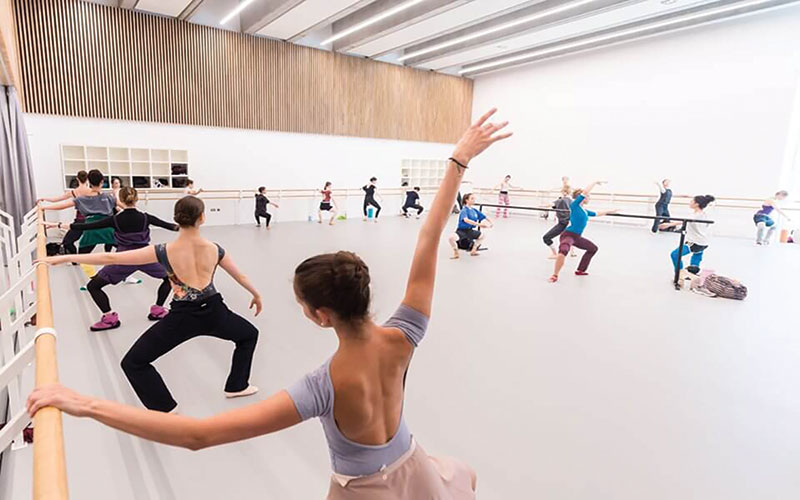The correct dance floor makes an important contribution to the safe performance of dancers without the risk of slips and falls or longer-term stress injuries. A good dance floor instils confidence in dancers to give full expression to their creativity, safe in the knowledge the dance floor will offer a consistent response. Harlequin Floors have developed floors specifically for dance, offering the exact requirements needed for varying genres of dance, which commercial grade, industrial and sports floors cannot.
Experienced dancers can judge a good floor instinctively as to whether or not it fells right. And if it feels right they can effectively forget about the floor and concentrate on putting all their focus and concentration into the artistic performance. A confidence that comes from a reassurance they are not going to slip and fall, that lifts can be performed safely and on landing from jumps the response of the floor consistently returns the right amount of energy absorption. Quantifying this subjective rating of a floor into a series of repeatable tests is no simple task. Anyone specifying floors for dance should remember that dancers may not be the commissioning clients, but they are the end users. Major dance companies understand this, which is why it is not uncommon to ask their dancers to ‘test’ floors before the final choice is made.
Research in recent years has identified a correlation between the consistency of dance floors and injuries incurred by dancers. When specifying a floor for dance, using general flooring or sports floor standards will not ensure the right floor is installed. Only a floor developed specifically for dance will do. There have been some high profile examples where floors have had to be replaced by a dance company after the building is complete because the floor was not considered fit for purpose by the dancers using it.
WHY SPORTS FLOORS ARE NOT SUITABLE FOR DANCE
It is tempting to presume that as the elite athleticism of top dancers is on a par with sports people, that a sports floor is appropriate. It is not. There are some critical factors to distinguish the requirements of dancers from those of sports played on a sports floor. Many sports played on these floors require a firm floor which allows balls to bounce predictably. Sports footwear is generally cushioned to protect against impact injuries. The footwear also provides grip for the sports person. By contrast, dancers need more absorption or cushioning on landing from jumps. Their footwear varies according to dance style and doesn’t cushion landings. Dancers also need the right degree of traction from the dance surface.
Harlequin work extensively with dance scientists and biomechanics experts to investigate the effects of the choice of dance floor on dancer performance and injury, and to research and develop floors that minimise these risks.
Biomechanics expert, Luke Hopper, explains: “Injury occurrence is all too common in dance. Dancers will always push their bodies to the limit to get the most out of their training, it is therefore very important that safe dance environments are created by reducing any unnecessary injury risks”.
Dr Boni Rietveld is an orthopaedic surgeon at the Centre for Medicine, Dance and Music in The Hague, Netherlands, and is also Past President of the International Association for Dance Medicine and Science. Boni observed: “There is a distinction to make between injuries caused by the floor and those caused accidentally. As far as the former are concerned, it is evident that there is a cause and effect relationship between dancers’ injuries and the floor on which they perform”.
HARLEQUIN’S CPD PROGRAMME
As part of Harlequin’s commitment to protecting the health and wellbeing of dancers and performers, our RIBA approved CPD explains why specifying the correct floor for dance and performing arts is critical to the longevity of a performers career.
Using comprehensive data and case studies, we outline the key considerations when specifying a performance floor and look at the important contribution the floor makes to performer health and safety. We explore the history of dance floors, the reasons why floor choice is so important, current standards and tests and how to ensure you specify the right performance surface.
Harlequin is the world leader in advanced technology floors and stage systems for the performing arts and is the industry choice for the world’s most prestigious dance and performing arts companies, theatres, venues and schools. Harlequin manufactures, supplies and installs a range of high quality sprung and vinyl floors and specialises in the building and refurbishment of bespoke stage systems.
Harlequin Floors
Tel: 01892 514 888
http://www.harlequinfloors.com
Email: [email protected]


